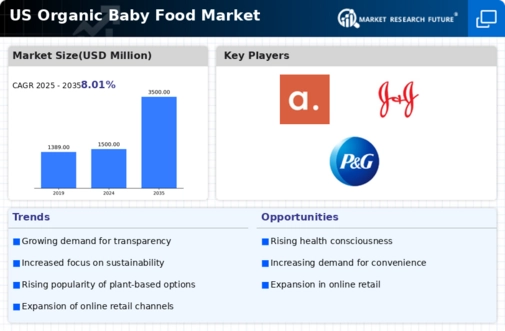Expansion of Product Offerings
The organic baby-food market is witnessing an expansion of product offerings, catering to diverse consumer preferences and dietary needs. Brands are increasingly introducing a variety of flavors, textures, and formats, including purees, snacks, and meal kits. This diversification is essential in attracting a broader customer base, including those with specific dietary restrictions such as gluten-free or allergen-free options. The introduction of innovative packaging solutions, such as pouches and jars, also enhances convenience for parents. As the market evolves, companies that adapt to changing consumer demands and preferences are likely to thrive in the competitive landscape of the organic baby-food market.
Influence of Millennial Parents
Millennial parents are significantly shaping the organic baby-food market, as they tend to prioritize health and wellness for their children. This demographic is more likely to research and invest in high-quality, organic products, reflecting their values of sustainability and nutrition. Data suggests that around 70% of millennial parents are willing to pay a premium for organic baby food, which indicates a strong market potential. Their purchasing decisions are often influenced by social media and online reviews, making digital marketing strategies crucial for brands in the organic baby-food market. As this generation continues to grow, their preferences will likely drive innovation and product development in the sector.
Rising Demand for Natural Ingredients
The organic baby-food market is experiencing a notable increase in demand for products made from natural ingredients. Parents are increasingly seeking baby food that is free from artificial additives, preservatives, and genetically modified organisms (GMOs). This trend is driven by a growing awareness of the potential health risks associated with synthetic ingredients. According to recent data, the organic baby-food market is projected to grow at a CAGR of approximately 10% over the next five years, indicating a robust shift towards organic options. As consumers prioritize transparency in food sourcing, brands that emphasize organic certifications and ingredient integrity are likely to gain a competitive edge in the organic baby-food market.
Regulatory Support for Organic Products
Regulatory support for organic products is playing a crucial role in the growth of the organic baby-food market. The USDA's National Organic Program establishes strict guidelines for organic labeling, which helps to build consumer trust and confidence in organic products. This regulatory framework not only ensures the integrity of organic claims but also encourages more producers to enter the market. As more farmers transition to organic practices, the supply of organic ingredients is expected to increase, potentially lowering costs for manufacturers. This supportive regulatory environment is likely to foster innovation and investment in the organic baby-food market, further driving its expansion.
Increased Awareness of Nutritional Benefits
There is a growing awareness among parents regarding the nutritional benefits of organic baby food, which is contributing to the expansion of the organic baby-food market. Research indicates that organic baby food often contains higher levels of essential nutrients and antioxidants compared to conventional options. This awareness is prompting parents to choose organic products to support their children's health and development. Furthermore, studies have shown that organic foods may reduce exposure to harmful pesticides and chemicals, which resonates with health-conscious consumers. As educational campaigns and research continue to highlight these benefits, the organic baby-food market is likely to see sustained growth.














Leave a Comment